By Jeffrey A. Rendall, Editor. Images courtesy of ESPN.com
Fitting it was, perhaps, that someone like Chad Campbell was the player making the 2003 PGA Tour's final stroke at the season ending Tour Championship. Fitting, because Campbell's victory was perfunctorily characteristic of a season that can only be described as 'atypical' in so many ways. Campbell would've fit in well with last year's theme -- 'first-time winner breaks through' -- though his strong performance also belongs squarely in 2003, where the exceptions trumped the norm.
It's safe to say, the 2003 PGA Tour season gave a lot of people hope. First, hope that youthful exuberance and competitiveness doesn't end at forty, since sixteen PGA tournaments were won by ten players over forty, and one over fifty. There was a season-long buzz over the consistently excellent play of 49 year-old Jay Haas, though it was 49 year-old Peter Jacobsen and half-century aged Champions Tour rookie Craig Stadler who were the oldest players to take home trophies from this year's Tour.
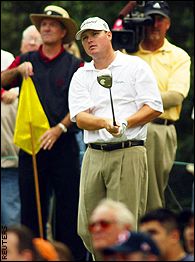 |
| Chad Campbell was a cool as a fall morning while winning the Tour Championship in Houston. Photo Courtesy of ESPN.com. |
Second, there's hope because 2003 was the season where the Tiger-factor finally merged back (somewhat) with the rank and file of the Tour. Tiger Woods certainly came to play in 2003, winning a tour-leading five times (in eighteen tries), yet the majority of the game's best players hardly rolled over and played possum whenever he came within sight, like they'd often done in the past. In recent years, Woods seemed to enjoy a lock on major championships -- either winning or having a chance on Sunday in nearly every event -- but in 2003, he carded only one top-ten finish in those four tournaments and garnered very little face time on TV during the final rounds. He did take home his fifth straight Vardon Trophy (for the year's best scoring average), yet his year was also plagued by erratic (to say the least) play from the tee and a moody putter.
Finally, hope sprang eternal because of the overall financial health of professional golf at the conclusion of the regular season. Recent years saw several long-standing events folding their tents up for good, yet every one of the 2003 Tour's tournaments will be back in 2004 (only the Las Vegas event lacks a sponsor). Similarly, the Champions Tour probably had its best season ever, with several recently graduated PGA Tour stars bringing a new competitiveness to the senior circuit (not to mention Tom Watson's emotional rise to the top with caddy Bruce Edwards). The Nationwide Tour also had its best year, and will add a couple new events in 2004. Finally, the LPGA, behind Annika Sorenstam's continued march though history, also drew much attention and acclaim.
In addition, despite middle school student Michelle Wie's failure to make much positive noise during her professional debuts on several different women's and men's tours (at least in the latter part of the year), her talent is abundantly evident, and it'll be fun to watch this future superstar's career develop.
In other words, the world of golf is prospering. TV ratings for the majors declined somewhat this year, due largely to the absence of Woods and the dominance of some heretofore relative unknowns, winning two of the most prestigious tournaments (Shaun Micheel (PGA) and Ben Curtis (British Open Championship)). But one also must reason, however, that fans who regularly watch golf for something other than the mere hope of another Tiger Woods triumph -- thought this year was one of the most entertaining and satisfying ever.
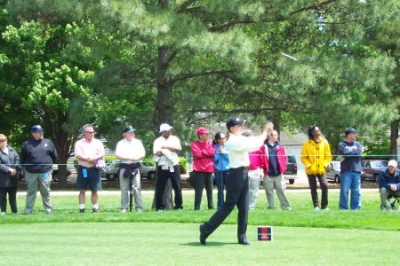 |
| Annika Sorenstam played in Virginia's Michelob Light Open prior to challenging the men at The Colonial. Photo by Kevin Gaydosh. |
John Madden recently said we're seeing some 'mediocre' football this season, but I'd challenge anyone to assert there was anything mediocre about the overall play on golf's professional tours in 2003. From Mike Weir's steady putting performance at the Masters, to Annika's impressive showing at The Colonial, to Campbell's stellar ball striking at the Tour Championship, we were treated to some incredible and consistent thrills.
And for those who missed it, Shaun Micheel's approach on the 18th hole at the PGA Championship definitely ranks up there with the most memorable shots of all-time. It doesn't matter that Micheel's not a superstar, or that his August triumph is the only victory of his career thus far. To rise to the occasion under such pressure was inspiring to all who witnessed it. Well done, Shaun.
Player of the Year, Revisited
In late September, I previewed the 2003 PGA Tour Player of the Year (POY) race, claiming several candidates had a solid chance to win the award -- yet arguing Tiger Woods probably wouldn't get the necessary votes because of his lackluster performance in this year's majors.
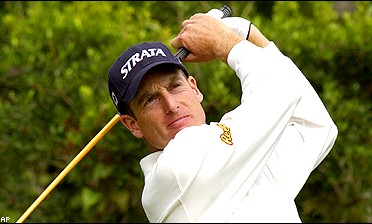 |
| Jim Furyk won the US Open in June, but probably doesn't have a shot at player of the year. Photo courtesy of ESPN.com. |
Things definitely moved in the time intervening, however, with Woods capturing the American Express Championship in convincing fashion, but falling just short of Vijay Singh in season earnings. Meanwhile, fellow POY nominees Mike Weir, Jim Furyk and Davis Love III failed to build on their earlier season accomplishments. Most observers believe the race has been narrowed to Woods and Singh, for a plethora of reasons.
ABC Commentators Curtis Strange and Ian Baker Finch say Woods should win, because of his five wins and lowest scoring average. Honorary world POY Ernie Els said he's leaning towards Singh because of the money title, but he wants a chance to examine the statistics before casting his vote.
Mike Weir says he's as deserving as any, despite his lukewarm play in the second half of the season... and it goes on and on, with many different arguments bolstering many different positions.
Not wanting to be a fence sitter, this reviewer would cast his vote for Vijay Singh, and the reasons are plain. Singh was the most consistent performer on Tour in 2003, with four victories and eighteen top-tens to his credit -- in addition to besting Woods by $900,000 in total earnings (and also topping Woods in the 'actual scoring average' category).
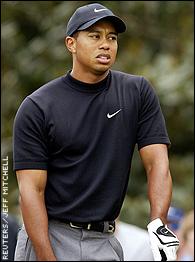 |
| Tiger looked frustrated at the Tour Championship. Photo courtesy of ESPN.com. |
Those who tab Woods claim his five victories, including two in World Golf events, are more impressive than Singh's four wins and his triumph in the money race.
But are they?
True, Woods won the world events, the American Express and the Accenture Match Play championships, which feature the top ranked players from all corners of the globe. But I'd argue that Singh's victories in full-field PGA Tour events are just as impressive, if not more so -- simply because world rankings, save for the top players, just don't seem to mean much outside of admissions requirements for the cream of the crop tournaments. For example, most of the top players on the 'other' tours have never won a PGA event, with names like Colin Montgomerie and Padraig Harrington immediately coming to mind. This is not saying the world golf events don't feature talented fields -- they certainly do.
But don't cheapen Singh's victories in comparison, either.
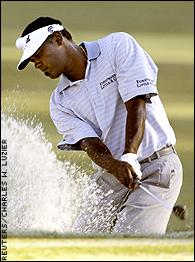 |
| Vijay Singh didn't find himself in trouble often in 2003 -- and when he did, he got out. |
Others say Woods got his victories in drastically fewer tries, playing only eighteen events to Singh's twenty-seven. So what? Singh plays more than Tiger, all over the world. Tiger was injured at the beginning of the season, too -- and certainly could've chosen to enter more tournaments towards the end, if he wanted to ensure winning the money title (like Singh did). Winning the money title would've guaranteed that Woods took home the player of the year votes. Fact is, he didn't.
If anyone has the right to determine his schedule, it's the world's #1 player. But picking and choosing certain tournaments carries with it the risk of foregoing some accomplishments -- notably the money list, and possibly because of it, player of the year.
The final factor, in my opinion, should be performance in the game's toughest events, the majors. In 2003, there's no question Singh wins here. Woods' major finishes were as follows: T15 (Masters), T20 (US Open), T4 (British Open) and T39 (PGA), his worst finish ever in a major. Singh didn't win a major either, but he finished tied with, or higher than Woods in each event: T6 (Masters), T20 (US Open), T2 (British Open) and T34 (PGA).
Add in their respective results at the Tour Championship, and it's even clearer. Singh survived a poor first round to finish tied for fifth, and Woods never found the rhythm, finishing twenty-sixth (out of thirty-one players).
The issue's certainly debatable, but on the merits, Singh seems to have come out a bit ahead. True, he earned one less victory (in nine more events), but Singh's numero uno on arguably the most important statistic, money earned. Finishing number one in money was an important enough goal that Woods wanted it desperately in 1997 -- so he'd have an greater chance of winning player of the year. And that's exactly the reason why Singh should win the title in 2003.Details:
A good source for golf news is www.pgatour.com
| Related Links | Comments on this article? | |
|
Maryland National Golf Club Hollow Creek Golf Club Rocky Gap Resort PB Dye Golf Club in Ijamsville Whiskey Creek Golf Club |
E-mail Jeff Rendall, Editor: jrendall@golftheunitedstates.com |












